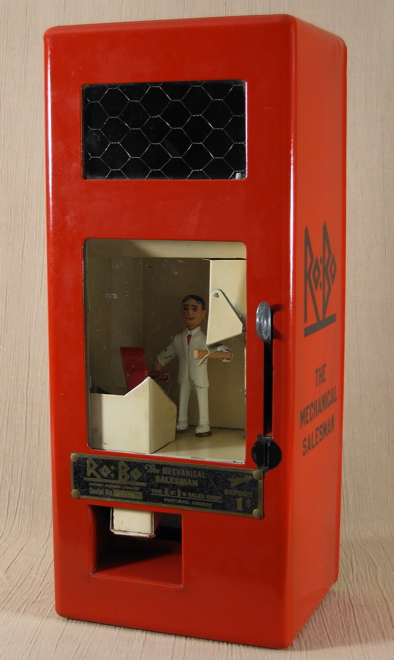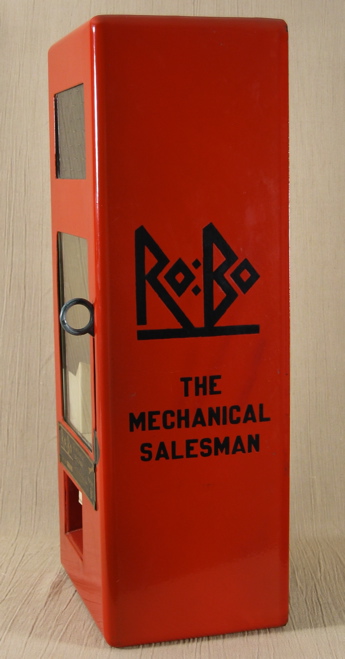___________________________________________________________________________________________
Ro-Bo Mechanical Salesman


___________________________________________________________________________________________


Ro-Bo Sales Corp, Portland, OR, c. 1929, 20". I was immediately struck by the resemblance of this machine to the Manikin Vendor and the Scoopy, and Silent Salesmen Too explains why. The Ro-Bo has the same patent number as those 2 vendor lines, although I suspect that the dates of production differed. The tags on the Ro-Bo and Manikin Vendor both list Portland, Oregon as the location of the company, which is yet another clue to a familial connection. I think the Ro-Bo is the earliest of the 3, followed by the Manikin and then the Scoopy.
The Ro-Bo is a bulk vendor that's bigger than the gumball-dispensing Manikin Vendor. The mechanism on this is extremely temperamental, although there may be a simple explanation for its unreliable performance in collectors' hands---more about that below. It took me awhile to confirm that this machine works as designed. The little man in the Manikin Vendor and the Scoopy moves at a measured pace, but the man in this machine whips around spastically, like he's been up for 2 nights straight binge-drinking espresso. Silent Salesmen Too says that "when a coin is deposited, the puppet nods his head, fills his basket, and delivers the merchandise with a nod of thanks." I've not tried merchandise in this machine, but it seems to me that the puppet would partially fill his basket and then fling that merchandise around the inside compartment while the rest of it falls to the floor. I've not seen the nods, but I may have missed them in the blur of the little man's motion.
Let's talk about the temperamental nature I described above. The major problem with the mechanism is that the little man seldom returns to his proper starting point, and when he doesn't return to the correct starting point then he doesn't do what he's supposed to do on the next cycle. After nearly an hour of testing this mechanism and resetting it from the rear after each penny was run through, I finally figured out that the machine works as designed, but that the design and execution are flawed. I know of only a few other Ro-Bo's, and the owners of 2 of them have the same problem. That tells me that this isn't a quirk of this particular machine, rather it seems to be endemic to the model.
Now it's possible that the quick action and unreliable action are related. Specifically, the quick action may give the spastic little man so much inertia that he just can't stop in the right location, and that incorrect stopping point throws off the next cycle. If so, then it's possible that it could be solved. Part of the mechanism is a cylinder that contains oil, and based on its location it appears that the oil cylinder is supposed to dampen the mechanism's speed. The collector from whom I got this used sewing machine oil in the cylinder, but that may not be the right weight of oil to use in it. I'm not inclined to try different oils until I find one that works, but it wouldn't surprise me if a more viscous oil slowed the little man's motion enough to vend the merchandise properly and to give it the right speed to stop in place and produce a much more reliable vending cycle. I called the company for advice, but their number's been disconnected.
If the oil weight doesn't explain the spastic action and inconsistent performance, then this is just an unreliable vendor, and that could explain why so few exist. Even if the right oil makes it work better, my experience with this mechanism causes me to think it would still be more temperamental than most, and therefore wouldn't be very well-accepted commercially. Given its unreliable nature and the fact that so few exist, it wouldn't surprise me if the company made only a tiny run of this model and realized rather quickly that it wasn't going to be a big seller.
Now as I reread what I wrote above it sounds like I'm denigrating the machine, and that's not my intent. This is a rare machine that's, in my opinion, historically important in that it spawned the Manikin and Scoopy lines of commercially successful vendors that most of us know and love. I'm not planning to use this on a vending route so I don't care about the flaws, as long as the mechanism isn't broken---and it's not, it's just terminally temperamental. I do care about the beauty of the piece and its historical importance, and it has both of those features in spades. Unless somebody has evidence otherwise, I believe that the Manikin and Scoopy lines were direct successors of this model, and that makes it intriguing. I think the Manikin Vendor came shortly after the Ro-Bo and is a much better vendor, and that the Scoopy came along even later, in the 1950s. The Manikin and Scoopy also have complicated mechanisms, but they seem to be pretty reliable.
The machine pictured above is 100% original and is one of only a few examples I know to exist. The others are also finished in red porcelain except for one, and that one is finished in the same shade of green porcelain as some other machines of this era (for example, the Columbus Dart). This model was designed to be wall-mounted, but sits level on a flat surface. I pass along that last bit in case you stumble across one of these for $100 and think, "Oh golly, and to think that I have all those empty shelves but am plumb outta wall space---I guess I'll have to pass."
___________________________________________________________________________________________
___________________________________________________________________________________________
©Small Vintage Vending 2019